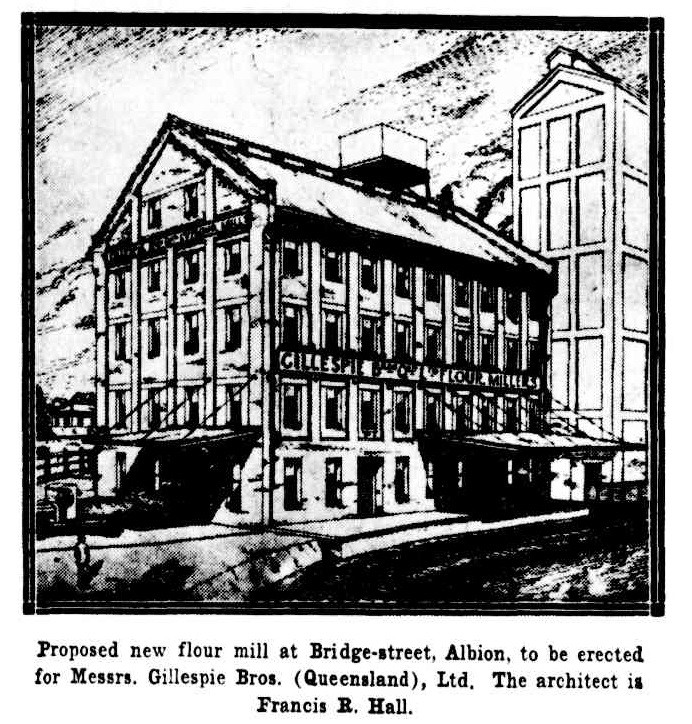The Albion flour mill, Scottish links and another era
By JOL Admin | 5 December 2013
Albion is a Brisbane suburb which was established early by a number of Scottish pioneers. Among them were John Petrie, an 1837 arrival, who opened a quarry there, the Campbells of James Campbell & Sons building suppliers who came on the John Fielden in 1853 and the McLennans, early farmers, who arrived on the William Miles in 1855. Frederick Marsden, timber merchant came later on the Duntrune in 1883. Their early presence is reflected in local names to be found in and around the area.
The Albion flour mill reflected a more recent Scottish influence. It was constructed after the pioneer era and was important for a number of reasons, not least for the employment it provided. Tenders were called for an architect and builders in 1930 during the Depression. The mill was completed in 1931 and so contributed to the area by providing much needed jobs for a range of workers from millwrights, carpenters, and carriers to stenographers.

Francis R Hall (1862-1939), was a Brisbane born architect. The flour mill project came at a useful time for him as a major job at the start of the Depression. F.R. Hall was primarily a manager, depending in his many practices on partners who were talented designers – E.M. Myers (1864-1926), R..S (Robin) Dods (1868-1920, A.E. Brooks (1872-1958) and W. Alan Devereux (1899 -1977). The flour mill was probably designed for Hall by Harold Morton Cook (1901-1968) who shortly afterwards became Hall’s partner. The Hall & Cook partnership lasted until Hall’s death in 1939 and is well known for buildings such as the former AMP Building on the corner of Queen and Edward Streets.
The owners were the Gillespie Brothers whose father George, a Scottish immigrant, had established a successful grain products business in Melbourne. The Gillespie brothers: John, Robert Winton and George had developed a flour-milling business in Sydney and a well-known product, Anchor flour. The Gillespies had mills in NSW and Victoria and were seen as being in the front line of development. As early as 10 February 1904, the Sydney Mail featured a multi-paged, illustrated article on their roller flour mills.
The builders who won the construction tender, announced in the Brisbane Courier 16 September 1930, were also Scots, the Stuart Brothers: William and James, originally from Aberdeenshire. Based in Brisbane and Sydney, they were noted for their interest in new approaches.
There was praise for southern enterprise and for this modern and efficient flour mill at Albion. It was five-storeys, built of brick and concrete, with wooden floors and equipped with all the latest equipment for flour milling. At the rear of the building a large silo stored wheat. The building was efficiently connected to the main railway line at Albion. Gillespies spent £60,000 building the mill. It was worked three shifts a day almost continuously in the early days. An additional £20,000 almost doubled the mill’s capacity. A new storage shed and other additions brought the total cost of the mill to about £100,000. Two silos were added during the 1960s.
Over the years the fortunes of the mill waxed and waned. Issues concerned with millers benefitting at the expense of growers and southern grain being dumped on the Queensland market influenced profits and perceptions. Sir Robert Winton Gillespie, as he became in 1941, had a significant role beyond Anchor flour. He was a director of the Bank of New South Wales and interested in expansion into wheat-growing in Western Australia when the Albion mill was built. He was a director of the Colonial Sugar Refining Co. (1929-40), the Queensland Insurance Co. Ltd, and chairman of Ball & Welch Ltd, Melbourne softgoods merchants.
He contributed to charities mostly in the southern states but also to the “Crippled Children’s Fund” in Queensland.
Anchor flour had given way to White Wings on the Albion site by 1957. From 1983 the long-established firm of the O’Briens on the Darling Downs, Defiance flour owned the mill until 2002. Allied Mills then took over many mills including Albion which closed in 2004. Plans for “mixed use” redevelopment commenced. The fire which saw the mill destroyed on 27 November has put an end to its reuse.
Apart from providing employment, the mill was a dominant landmark and a well-known reference point for directions. Another significant structure in Albion, Campbell’s tower, an 18 metre high chimney on Hudson Road used as a wood-drying kiln, was razed in 1989.
The mill and Campbell’s tower are reminders of an earlier era when flour and timber were major industries in Albion and the Scots played an important role in developing business in the area. The physical presence of these structures however has gone forever.
Stephanie Ryan - Senior Librarian, Information Services, State Library of Queensland with Don Watson - historian and architect
Comments
Your email address will not be published.
We welcome relevant, respectful comments.